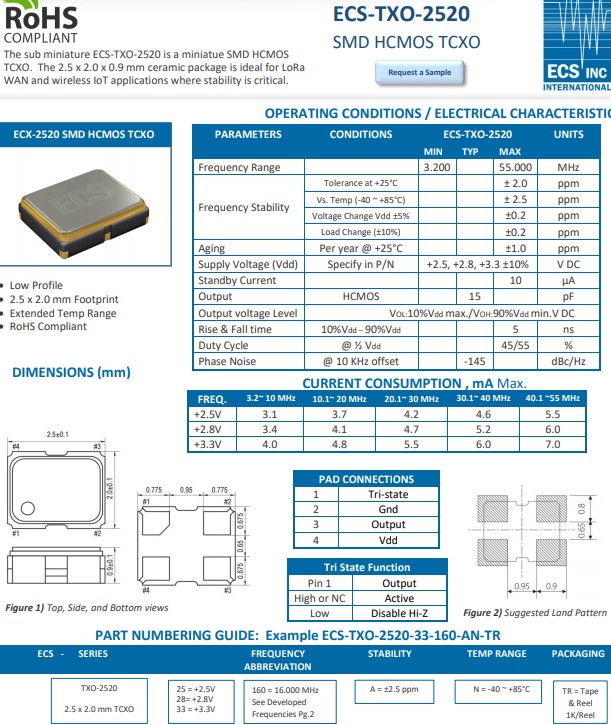微型的HCMOS输出温补晶振很适合无线物联网应用ECS-TXO-2520-33-120-AN-TR
微型的HCMOS输出温补晶振很适合无线物联网应用ECS-TXO-2520-33-120-AN-TR,Startup time is the period when an oscillator is first turned on. During this period there will be instabilities until the oscillations stabilize. Start-up time is usually measured in microseconds (µS), but it is frequency dependent and controlled by the feedback loop. The magnitude of the closed loop gain has great influence on the startup time. Factors that negatively affect closed loop gain include the low drive level, higher values of crystal capacitive load (CL), and equivalent series resistance (ESR). Low gain can cause excessively long start-up time, and too high of gain can cause start-up to fail altogether or over drive the crystal structure. The ideal gain is dependent on the negative resistance of the oscillator circuit, where the drive must overcome the negative resistance to start-up and build the oscillator output. Because of this the oscillator frequency directly influences the start-up time, so the time it takes to circulate the loop is considerably longer for a KHz oscillator than a MHz oscillator. Poor gain margin is a common problem in kHz oscillators, since drive levels are an order of magnitude lower and crystal ESR’s an order of magnitude higher. To overcome these issues careful design is required to match drive levels to suitable CL and ESR values.
The impedance of quartz crystal changes so dramatically with changes in the applied frequency, that all other circuit components can be considered as being of essentially continuous reactance. Consequently, when a crystal unit is used in the feedback loop of an oscillator, the frequency of the crystal unit will regulate itself so that it presents a reactance which satisfies the loop phase gain. A representation of the reactance vs. frequency of a quartz crystal unit is displayed in Figure 3.
启动时间是石英晶体振荡器第一次开启的时间。在此期间,将出现不稳定,直到振荡稳定。启动时间通常以微秒 (µS) 为单位,但它取决于频率并由反馈回路控制。闭环增益的大小对启动时间影响很大。对闭环增益产生负面影响的因素包括低驱动电平、较高的晶体电容负载 (CL) 和等效串联电阻 (ESR)。低增益会导致启动时间过长,增益过高会导致启动完全失败或过度驱动晶体结构。理想增益取决于振荡器电路的负电阻,其中驱动器必须克服负电阻才能启动并建立振荡器输出。因此,振荡器频率直接影响启动时间,因此KHz振荡器的循环循环时间比MHz振荡器长得多。增益裕度差是kHz振荡器的常见问题,因为驱动电平低一个数量级,而晶体ESR高一个数量级。为了克服这些问题,需要仔细设计以使驱动电平与合适的CL和 ESR值相匹配。
 微型的HCMOS输出温补晶振很适合无线物联网应用ECS-TXO-2520-33-120-AN-TR,石英晶体的阻抗随着应用频率的变化而变化如此剧烈,以至于所有其他电路SMD有源晶振元件都可以被认为具有基本连续的电抗。因此,当晶体单元用于振荡器的反馈回路时,晶体单元的频率将自行调节,使其呈现满足回路相位增益的电抗。图 3 显示了石英晶体单元的电抗与频率的关系。
微型的HCMOS输出温补晶振很适合无线物联网应用ECS-TXO-2520-33-120-AN-TR,石英晶体的阻抗随着应用频率的变化而变化如此剧烈,以至于所有其他电路SMD有源晶振元件都可以被认为具有基本连续的电抗。因此,当晶体单元用于振荡器的反馈回路时,晶体单元的频率将自行调节,使其呈现满足回路相位增益的电抗。图 3 显示了石英晶体单元的电抗与频率的关系。
| Manufacturer Part Number原厂代码 | Manufacturer品牌 | Series型号 | Frequency 频率 | Operating Temperature 工作温度 |
| ECS-2033-200-BN | ECS晶振 | ECS-2033 | 20MHz | -40°C ~ 85°C |
| ECS-2033-320-BN | ECS晶振 | ECS-2033 | 32MHz | -40°C ~ 85°C |
| ECS-2033-320-BN | ECS晶振 | ECS-2033 | 32MHz | -40°C ~ 85°C |
| ECS-2033-320-BN |
有源ECS贴片晶振 |
ECS-2033 | 32MHz | -40°C ~ 85°C |
| ECS-TXO-2520-33-120-AN-TR | ECS晶振 | * | 12MHz | -40°C ~ 85°C |
| ECS-TXO-2520-33-120-AN-TR | ECS晶振 | * | 12MHz | -40°C ~ 85°C |
| ECS-TXO-2520-33-120-AN-TR | ECS晶振 | * | 12MHz | -40°C ~ 85°C |
| ECS-2333-330-BN-TR | ECS晶振 | ECS-2333 | 33MHz | -40°C ~ 85°C |
| ECS-2333-330-BN-TR | ECS晶振 | ECS-2333 | 33MHz | -40°C ~ 85°C |
| ECS-2333-330-BN-TR | ECS晶振 | ECS-2333 | 33MHz | -40°C ~ 85°C |
| ECS-2333-200-BN-TR | ECS晶振 | ECS-2333 | 20MHz | -40°C ~ 85°C |
| ECS-2333-200-BN-TR | ECS晶振 | ECS-2333 | 20MHz | -40°C ~ 85°C |
| ECS-2333-200-BN-TR | ECS晶振 | ECS-2333 | 20MHz | -40°C ~ 85°C |
“推荐阅读”
- 1XXD32000MBA大真空DSB211SDN 2016 32M TCXO晶振
- NT5032SC-12.8M-NSA3341A 5032 NDK压控温补晶振
- 1XXD32000PBA DSB211SDN 2016 32M 温补TCXO KDS晶振手机充电为什么会电死人与石英温补晶振没有关系
- 全球自动汽车驾驶技术究竟发展到什么情况KDS晶振1XXA26000MAA DSA221SDN 2520 26M
- 1XXA10000MPA苹果手机iPhone14ProMax降价了DSA221SDN 2520 10MHZ
- ECS-RTC-3225-5609适用于便携式电池供电的小尺寸电子设备
- 20230206香港澳门和内地全面通关恢复往来对苹果14手机降价影响1XXD26000MAA晶振
- 苹果14系列影响苹果公司市值蒸发约4431亿元苹果手机晶振1XXD32000PBA
- 全球智能手机电脑手表耳机音箱等TCXO台湾晶技TXC温补晶振7L-26.000MCG-T
- 爱普生应对俄罗斯和乌克兰战争武器TG2520SMN爱普生温补晶振X1G005421021100
【责任编辑】:壹兆电子版权所有:http://www.oscillatorcrystal.com转载请注明出处
相关行业资讯
- 日本KDS大真空晶振7AD01600A3Z? DSX321G 16M
- ECS-3225MVQ-250-CN-TR伊西斯ECS晶振25M XO CMOS
- 1XXD32000MBA大真空DSB211SDN 2016 32M TCXO晶振
- 村田Murata晶振XRCGB32M000F1S1AR0 2016 6PF 10PPM
- 台湾TXC晶技晶振AH03200010 3215 32.768K 12.5PF 20PP
- NT5032SC-12.8M-NSA3341A 5032 NDK压控温补晶振
- ECS-80-12-30Q-DS-TR伊西斯ECS 5032 8M 12PF30PP两脚车规晶振
- TG-3541CE 32.7680KXA3爱普生十脚温补晶振1.5-5.5V车规-40+105
- 台湾希华XTL571300-U11-279晶振的科技价值3225 12M 12PF
- 1ZCM08000KK0B车规陶瓷晶振DSX320G两脚3225 8M汽车的精密心脏









